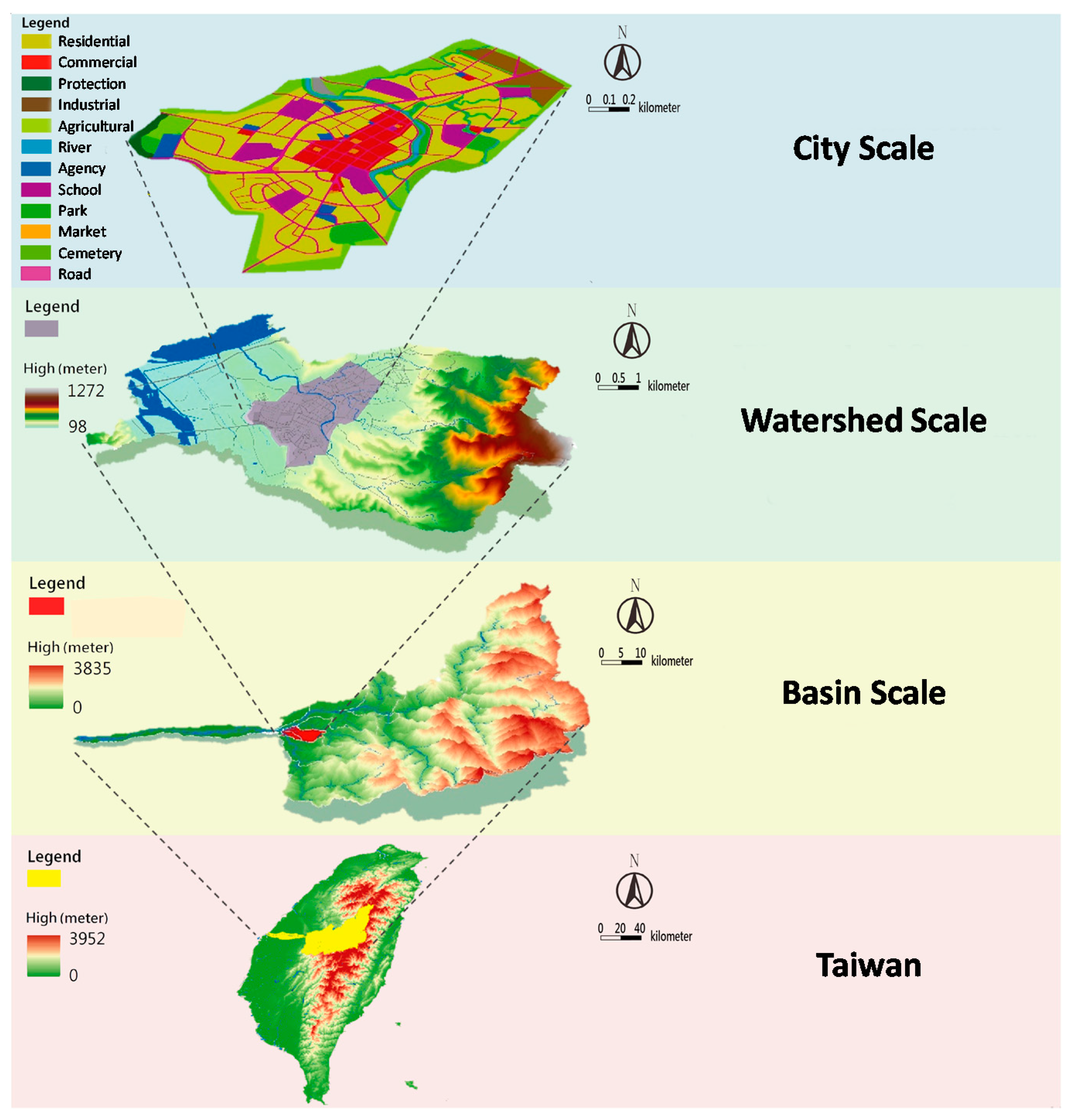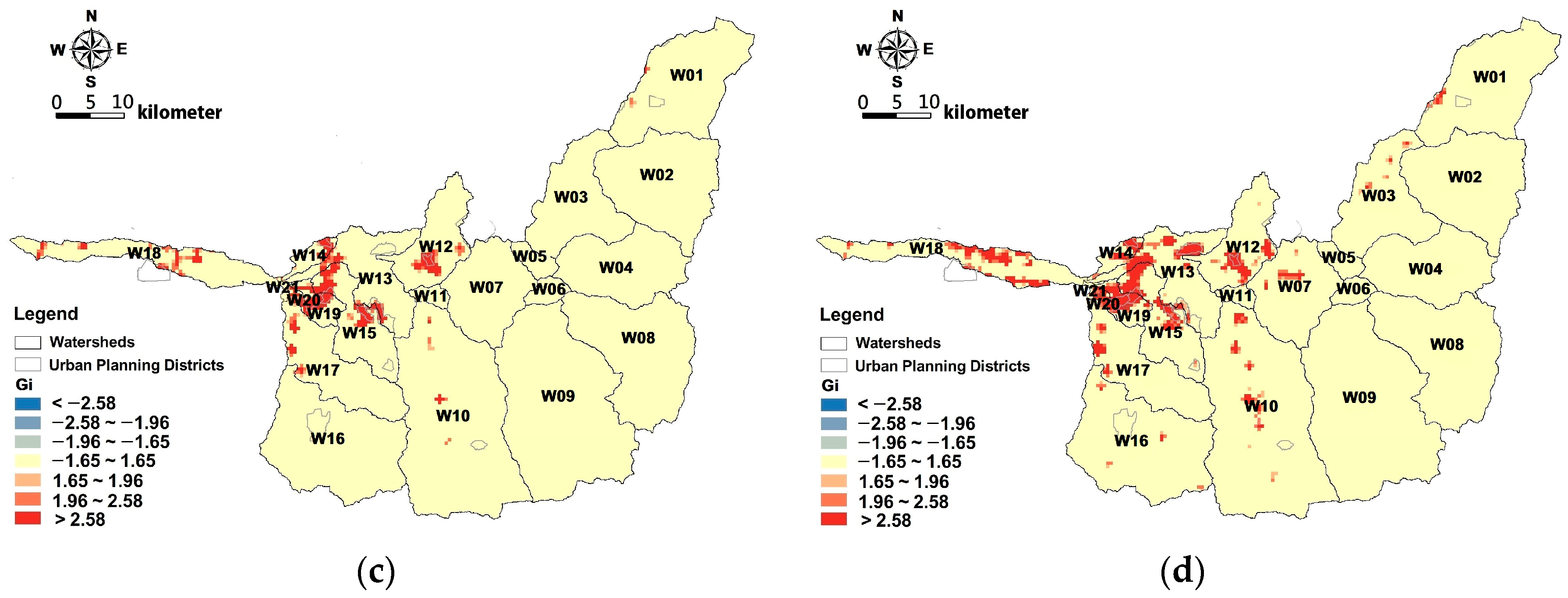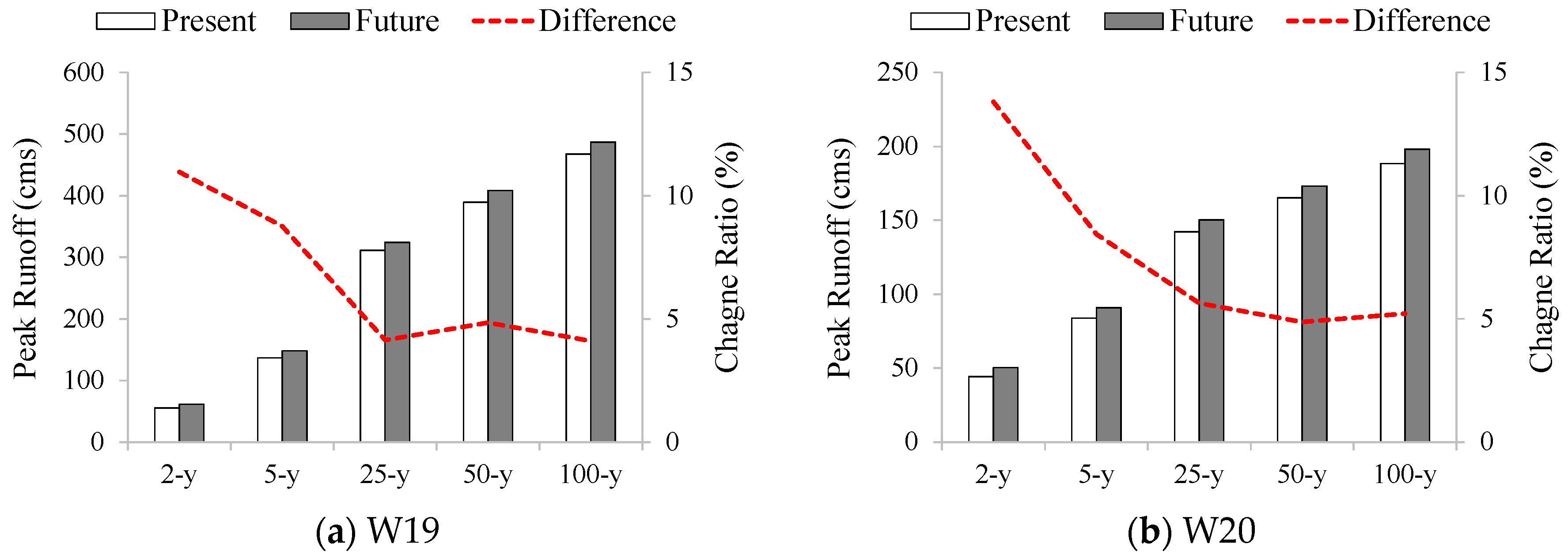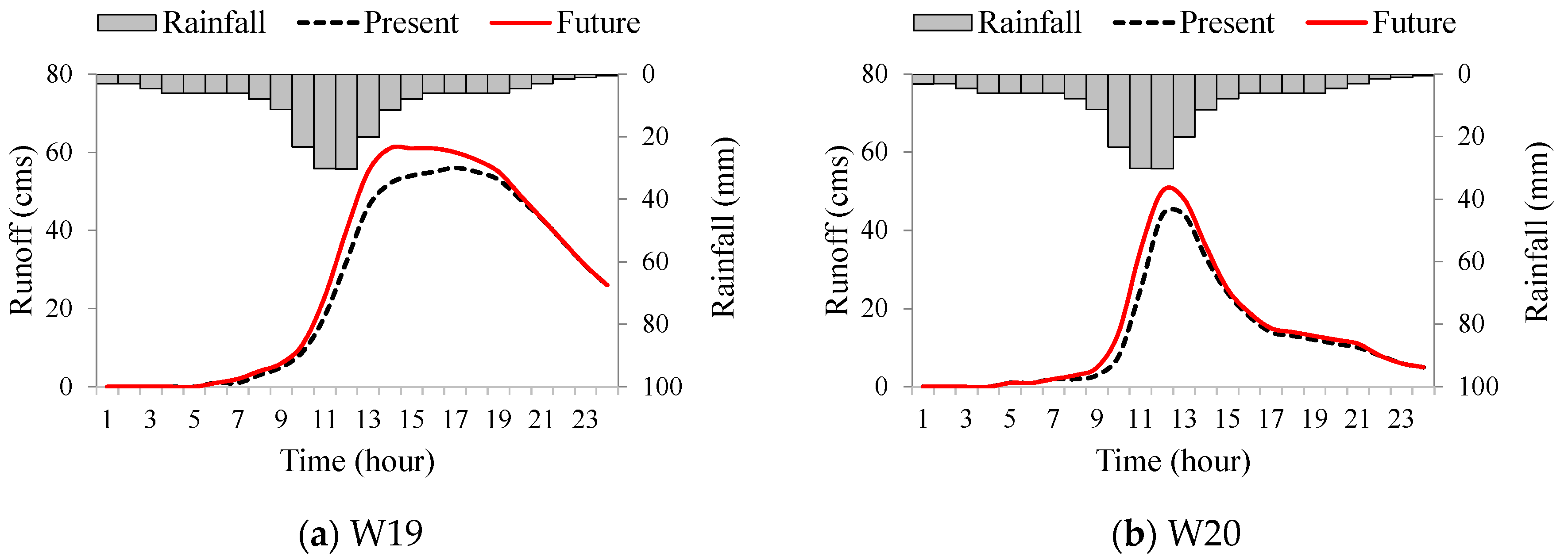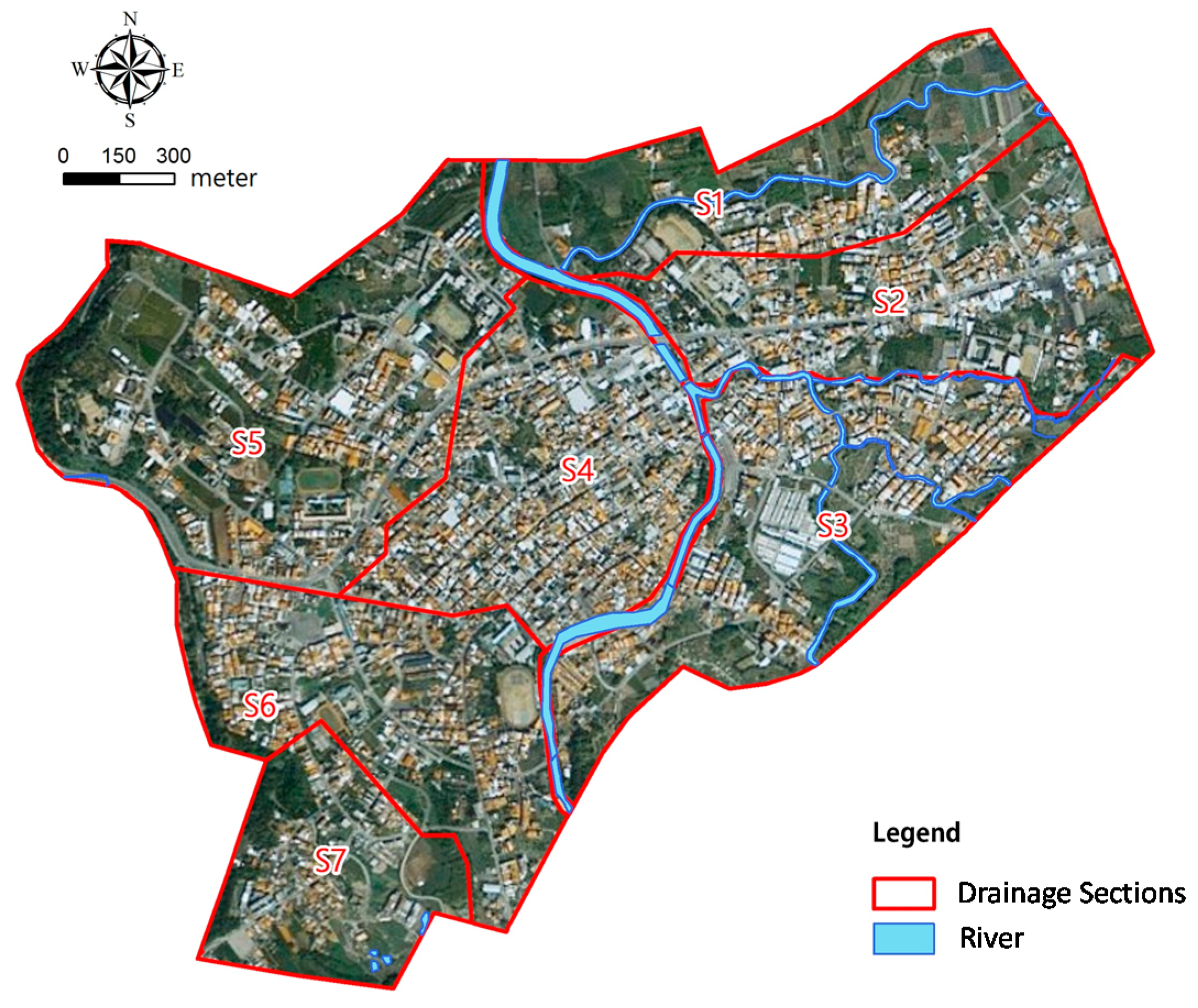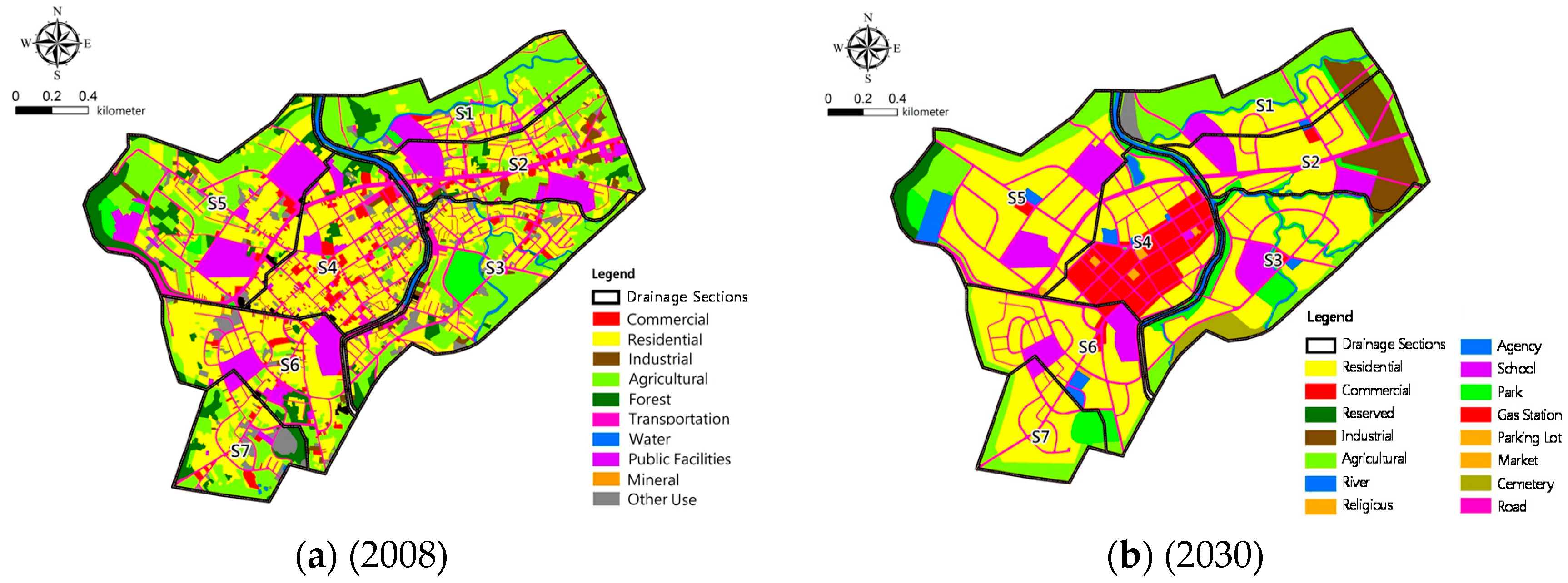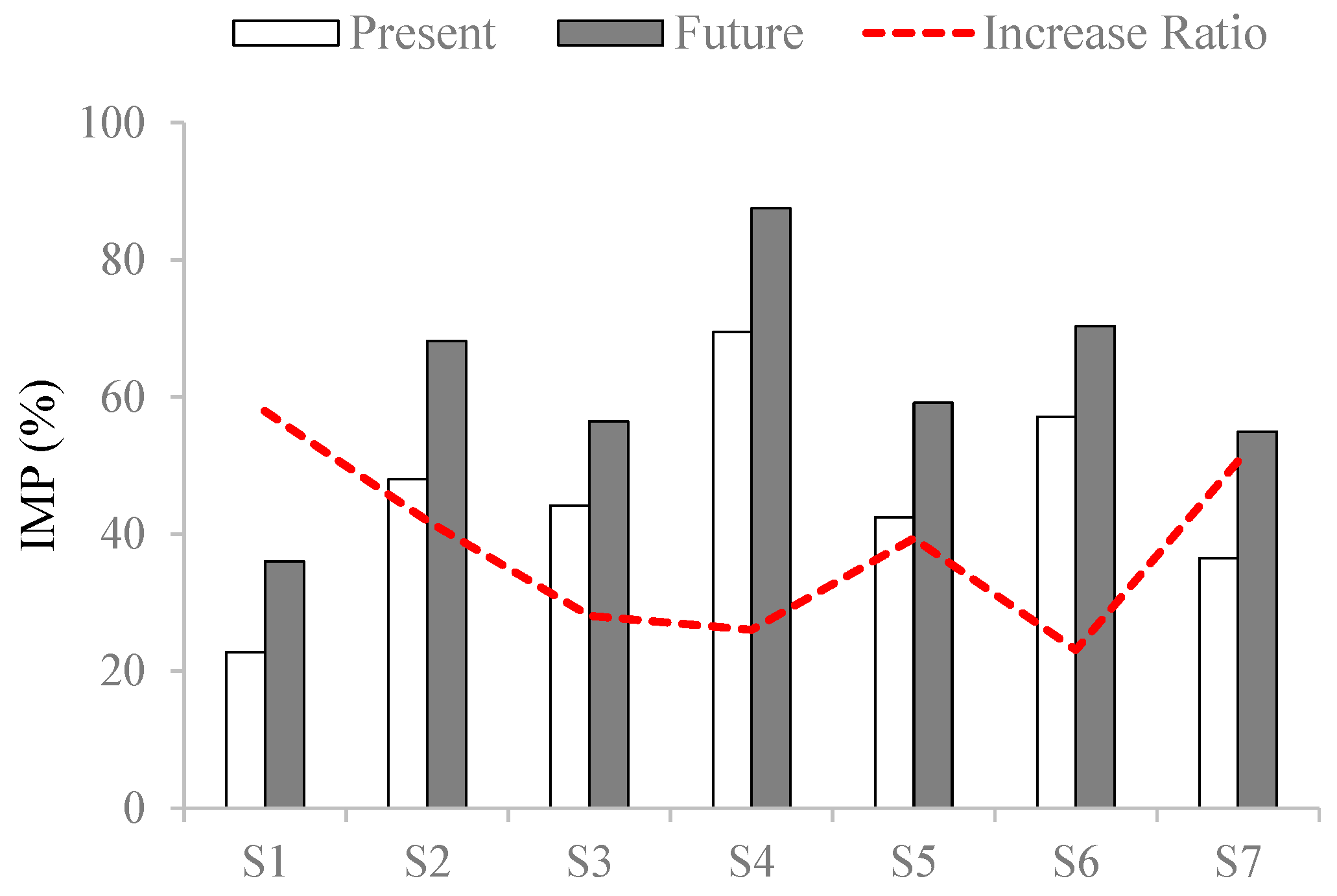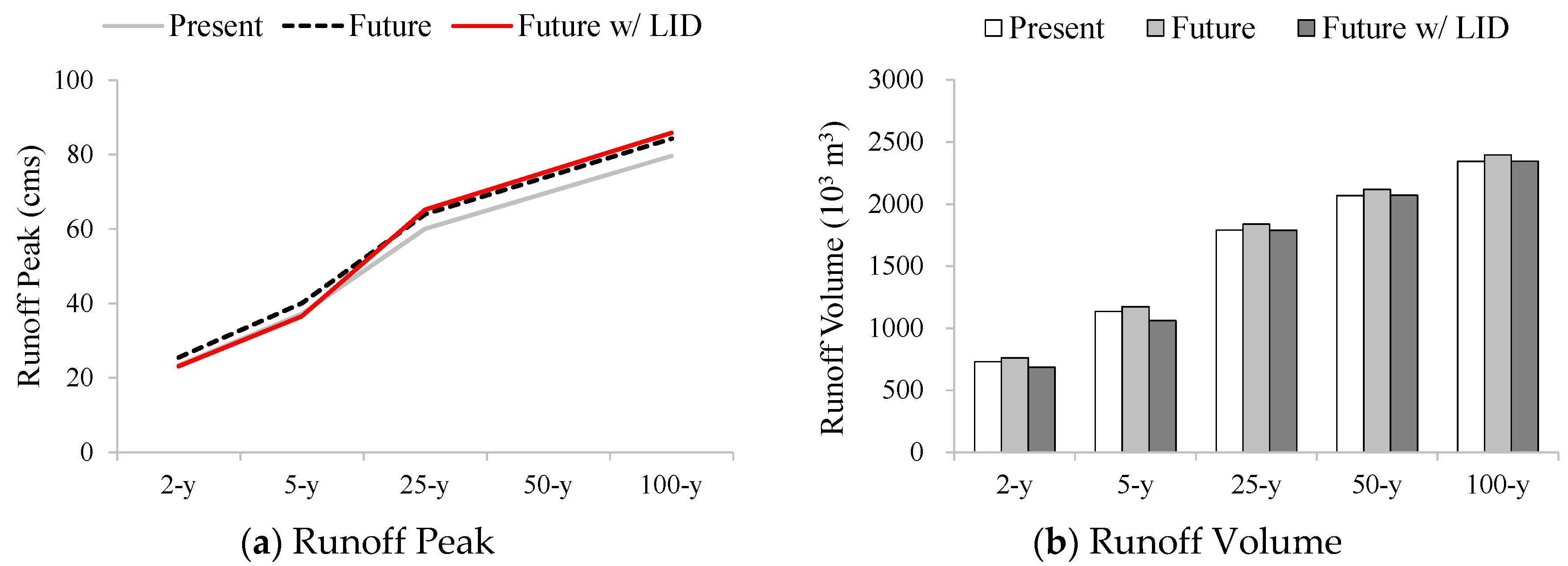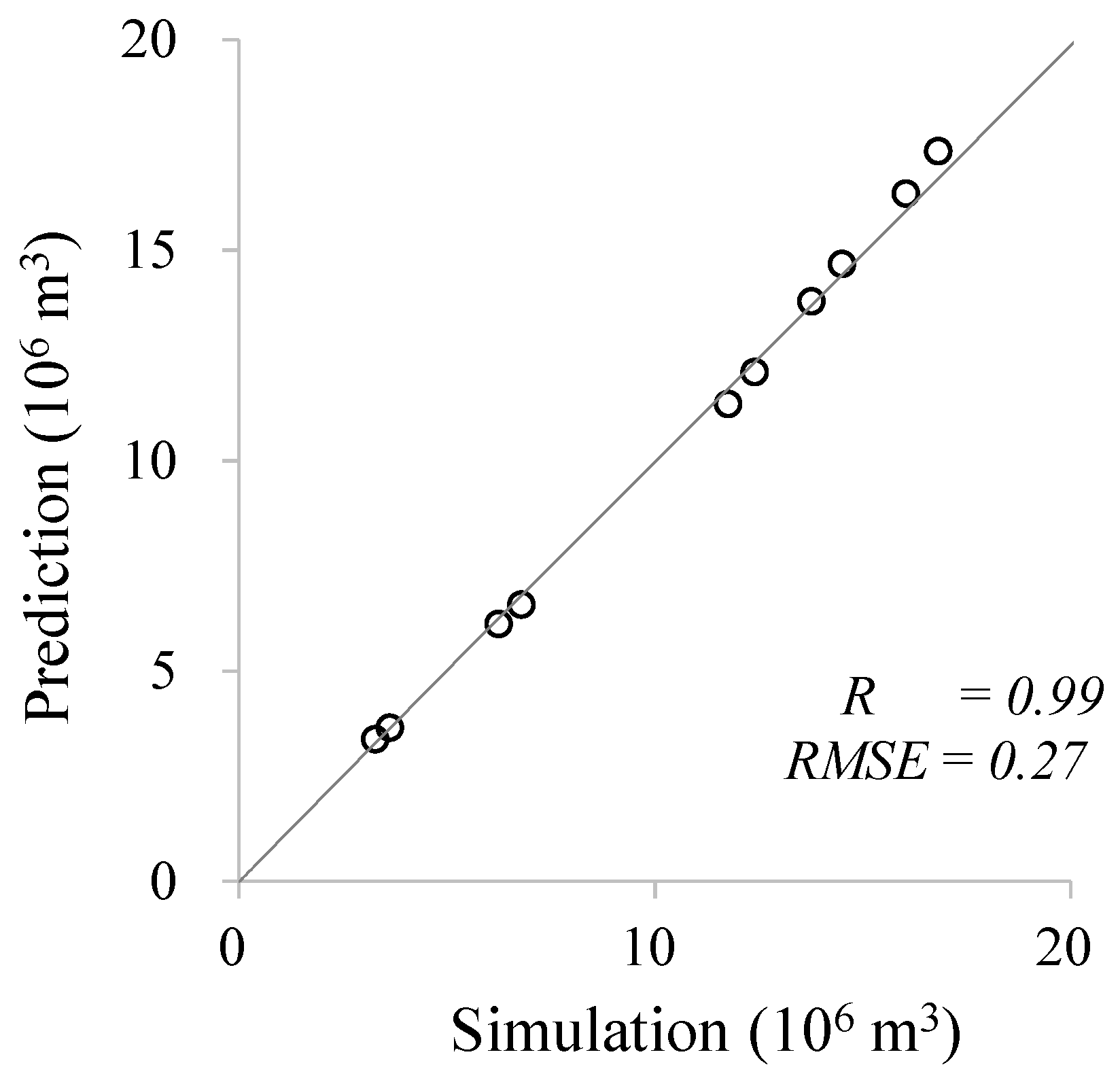4.1. Land-Cover and Runoff Changes on the Basin Scale
Table 2 summarizes the areas of water, built-up land, bare land, and vegetation in 1998, 2003, 2008, and 2013. Area changes for vegetation and water are not significant in terms of ratio because approximately 91.5% of the total land is covered by vegetation, 4% by water, 3.5% by bare land, and only 1% by built-up land. The built-up area showed a constant increase from 1990 hectares in 1998 to 3023 hectares in 2013, with a total increase of 51.91%. The area of bare land slightly increased from 8551 hectares in 1998 to 9650 hectares in 2003, and substantially increased to 14,561 hectares in 2008, followed by a decrease to 10,347 hectares in 2013, resulting in a total increase of 21% from 1998 to 2013. In contrast, the area covered by vegetation had the opposite pattern by decreasing constantly from 277,445 hectares in 1998 to 270,717 hectares in 2008 before subsequently increasing to 274,707 hectares in 2013. This finding indicates that there was a switch between the bare land and vegetation land from 1998 to 2013.
Table 3,
Table 4,
Table 5 and
Table 6 display the land-cover transfer matrixes between 1998–2003, 2003–2008, and 2008–2013, respectively. From
Table 3, the increase in built-up land, with a peak increase of 40.28% from 1998 to 2003, can be attributed to construction on vegetation land and bare land. Moreover, the increase in bare land displayed in
Table 3 and
Table 4 is a result of the deterioration of vegetation land, particularly from 2003 to 2008 when 10,170 hectares of vegetation land were converted into bare land. However, in
Table 5, a rapid recover of vegetation land from bare land between 2008 and 2013 is seen, with 6008 hectares of bare land being transformed into vegetation land. These phenomena can be explained by the occurrence of a devastating earthquake in 1999, with its epicenter located in the Chi-Chi area in the study river basin. During the Chi-Chi earthquake, slope lands became weaker and unstable, causing collapses and landslides that washed away vegetation covers in the typhoon seasons of the following 10 years. The recovery of vegetation land between 2008 and 2013 indicates that the slope land has regained stability. The significant increase in the built-up area between 1998 and 2003 can also be attributed to the Chi-Chi earthquake owing to the relocation and reconstruction of the buildings destroyed in the disaster. Thus, in the study area, the occurrence of a major earthquake speeds up urbanization by forcing more undeveloped land to become built-up areas.
To determine the spatial aggregation of artificial structures in the Zhuoshui River Basin, SAA is conducted in grid units with a resolution of 500 m.
Table 6 lists the Moran’s indexes, Z-score, and
p-value for 1998, 2003, 2008, and 2013. With all Moran’s I > 0, Z-scores > 2.58, and
p-values ~ 0, it demonstrates that the artificial structures in Zhoushui river basin are not distributed randomly in space, but are highly accumulated.
Figure 2 shows the hotspots of the artificial structures in 1998, 2003, 2008, and 2013, in which the grey lines are the boundaries of the 21 watersheds and the red color denotes the grids with higher
(Getis) values. The hotspots of artificial structures were concentrated in the watersheds around the bottleneck between the upstream catchment and the downstream river channel, particularly in watersheds numbered W19 and W20, which are thus chosen as the subjects for the medium-scale studies.
To initiate the HEC-1 model for runoff simulation, the 24-h rainfall amounts under different return periods are obtained from frequency analysis based on the historical records of the Chi-Chi rain station. The 24-h rainfall amounts under 2-, 5-, 25-, 50-, and 100-y return periods are 204.61, 308.29, 473.97, 543.38, and 612.50 mm, respectively. The rainfall hyetographs served for runoff simulation are determined by the intensity-duration-frequency relationships suggested by Horner and Flynt [
46] according to the design handbook published by the Water Resource Agency, Taiwan [
47].
Table 7 lists the parameters for the HEC-1 model and
Table 8 summarizes the CN, the area ratio of impermeability (IMP), and 100-y peak runoff discharge (
) on different scales. Overall, no significant changes are observed in CN, IMP, and
on the basin scale. This may be due to the fact that the land-cover are classified into four groups only, with vegetation land accounting for 91.5% of the total land, which limits the variation of CN and consequent runoff.
Table 8 also indicates that, because the W20 watershed has higher values of CN and IMP, it generates runoff of
, which is much higher than the basin average
.
4.2. Land-Cover, Land-Use, and Runoff Changes on the Watershed Scale
Present (2008) and future (2030) land-use maps on the watershed scales for W19 and W20 are illustrated in
Figure 3. Current land uses are divided into 11 categories, and the future land uses are further refined into 32 categories. By 2030, large areas of forests are set to be transformed into agricultural land and many residential regions will be converted into commercial areas. According to land-use changes from 2008 to 2030, for W19, the CN values increase from 60.55 to 62.31, and the IMP increase from 14.12% to 18.76%; for W20, the CN values increase from 69.75 to 76.48, and the IMP increase from 13.50% to 14.73%, as listed in
Table 8. However, in the overlay year of 2008, the CN values interpreted from land-use data are much larger than those interpreted from land-cover data (equal to 51.34 for W19 and 63.63 for W20), which can lead to different runoff estimations. These discrepancies are not surprising and can be attributed to the difference in land classification, as 11 types of land-uses exists but only four types of land-covers are classified. This finding indicates that uncertainty analysis should be performed if different sources of land data are incorporated for hydrological analysis; otherwise, their results should be regarded separately. In this paper, runoff variations resulted from land-cover and land-use changes are separately discussed.
Figure 4 shows a comparison of present and future runoff peaks under different return periods for W19 and W20, respectively. Peak runoff are demonstrated to increase in the future under all return periods for both W19 and W20. Although the increments of peak runoff are smaller at low return periods, their change ratios are instead larger. For both watersheds, the peak runoff under 2-y return periods increase by more than 10% and then drop to a level of 5% under return periods larger than 25 years. The runoff hydrographs under 2-y return period for W19 and W20 are displayed in
Figure 5, showing that future runoff peaks not only increase but also shift forward; the integration of runoff hydrographs against time shows that the total increases in runoff volume are 212,400 m
3 and 140,400 m
3 for W19 and W20, equivalent to 85 and 56 standard swimming pools, respectively. Such an increase presents a non-negligible extra risk of flooding if additional flood control measures are not implemented.
4.3. Land-Use and Runoff Changes on the City Scale
According to the sewer system report for Jushan in 2008 [
48], the Jushan District is divided into seven drainage sections as shown in
Figure 6 and the land-use maps for these sections at present and in the future are compared in
Figure 7. The figure indicates that, by 2030, the commercial area will greatly expand and will be mostly concentrated in S4; a large industrial block will be developed at the borders of S1 and S2; and the residential areas will be increased in almost every section.
Figure 8 indicates that the IMP for all the seven sections increase simultaneously, from 23–69% at present to 36–88% in the future, in which the S1 has the highest increase of
. The variations of average IMP and
on the city scale are also listed in
Table 8, which shows that this increased IMP will raise
from 79.62cms to 84.26cms by 2030.
Table 9 summarizes the parameters for SWMM.
In response to the increasing of flood risk, various LID measures are designed and incorporated into the SWMM on the city scale to evaluate their effectiveness of runoff reduction. To reduce public resistance, the LID measures are installed on government-owned lands or facilities. Some lands or facilities such as cemeteries, sewage treatment plants, and gas stations are discounted for LID because of their particular usages.
Table 10 summarizes the areas of different land-uses and the area ratios in which different LID facilities are installed. Rain gardens and bio-retention cells are installed in less built-up areas such as parks, parking lots, and plazas, while green roofs are mainly set up on the tops of markets, agencies, and schools. Using the LID control editor built in the SWMM, parameters of the LID facilities are given by different ground layers including surface, soil, and storage, as summarized in
Table 11. The surface and soil layers are porous, allowing water to pass through; the storage layer contains water within the soil void and when the storage is full, excessive water will overflow. In this study, no underdrains are considered. The IMP for each drainage section is adjusted for runoff simulation according to the area occupied by each LID facility.
Figure 9 shows the simulated runoff peaks and runoff volumes for different return periods under three land-use scenarios: present, future, and future with LID. Without LID, the runoff peaks and runoff volumes are found to increase simultaneously for all return periods due to the increase in IMP in future urban planning. The increased amounts at high return periods are slightly larger than those at low return periods, but not obvious. After introducing the LID facilities,
Figure 9a shows that the runoff peaks for 2-y and 5-y return periods will be effectively reduced to a level even less than the present condition. However, for the 25-, 50-, and 100-y return periods, the introduction of LID instead leads to slight increases in runoff peaks. In fact, this phenomenon has been discovered in previous papers (e.g., MaChtcheon, et al., 2012; Tao, et al., 2017), however, currently, no satisfactory explanation has been provided. Fortunately,
Figure 9b shows that LID does help to reduce runoff volumes no matter at high or low discharges. From the aforementioned case study, it is certain to say that the introduction of LID benefits flood mitigation at low discharges, but as discharge increases, the effectiveness of LID becomes trivial or unfavorable; consequently, LID should be implemented in conjunction with other flood mitigation measures.
Table 12 summarizes the runoff on watershed scale simulated by HEC-1 and those on the city scale simulated by SWMM, in which
,
, and
are the runoff volumes generated in W19, W20, and Jushan District, respectively. At low return periods, the
has a larger share in the total watershed runoff
than at high return periods. Considering that Jushan District only occupies 12% of the total watershed area, the city runoff volume at 2-y return period almost doubles no matter at present or in the future. This finding is quite reasonable because, compared with the city areas, rural areas have higher infiltration rates so that lower portions of rainfall will be transformed into effective runoff at initial stages. Through cross-analysis of the runoff results produced by HEC-1 and SWMM, the concomitant usage of different hydrological models on different scales is practical if the same land-use data are applied. Overall, at 2-y return period, LID can reduce approximately 10% of the city runoff volume, equivalent to 2% of the watershed runoff volume and 0.02% of the basin runoff volume.
By conducting statistical analysis on the results in
Table 12, the relationship between city runoff and watershed runoff can be expressed by the following equation:
in which
and
are runoff volumes on watershed and city scales, respectively;
and
are the area ratios of impermeability on watershed and city scales, respectively;
is the observed rainfall on city scale;
is the rainfall on watershed scale under 100-y return period. The coefficients
are determined by multiple regression analysis which yields
. With correlation coefficient
and Root-Mean-Square-Error
, the
values simulated by hydrological model are in good agreement with those predicted by the equation, as shown in
Figure 10. Being a general expression linking city runoff to watershed runoff, Equation (1) can be applied to any watershed, not only for the specific region in this study. When the ratio of
increases, the watershed will receive more rainfall water and generate more runoff compared with the city. A larger value of
represents that impermeable ratio at city increases compared with that at watershed; thus, the city will make a larger contribution to watershed runoff. The ratio of
allows us to predict watershed runoff from the rainfall observation at city; meanwhile, it reflects the phenomenon that the contribution of city runoff decreases at high discharges. The influence of land use will be implicitly included in the coefficients of
which vary with watershed conditions.
